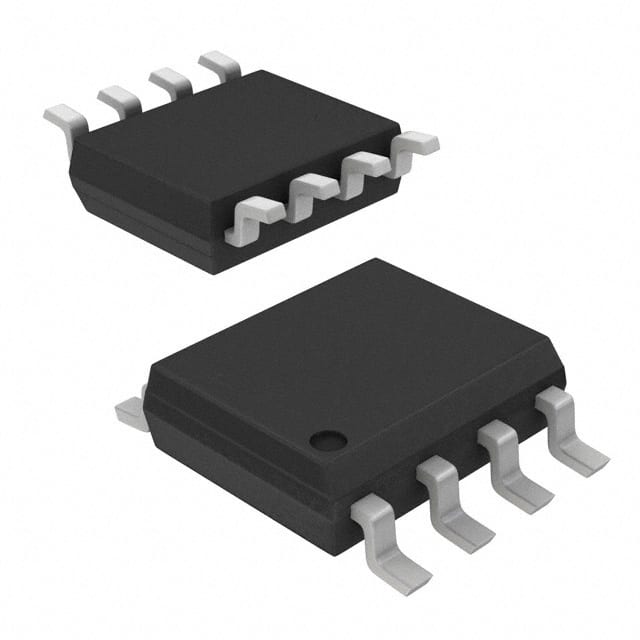Xem thông số kỹ thuật để biết chi tiết sản phẩm.

AD8400AR1
Product Overview
- Category: Integrated Circuit (IC)
- Use: Digital Potentiometer
- Characteristics: Low power, 8-bit resolution, non-volatile memory, single-channel
- Package: 8-pin SOIC (Small Outline Integrated Circuit)
- Essence: Provides a digitally controlled variable resistor function
- Packaging/Quantity: Tape and Reel, 2500 units per reel
Specifications
- Resolution: 8 bits
- Number of Channels: 1
- Supply Voltage Range: 2.7V to 5.5V
- Operating Temperature Range: -40°C to +125°C
- Resistance Tolerance: ±20%
- End-to-End Resistance Range: 10kΩ
- Interface: Serial Peripheral Interface (SPI)
Detailed Pin Configuration
The AD8400AR1 has the following pin configuration:
- VDD: Positive supply voltage
- CS: Chip select input for SPI communication
- SCLK: Serial clock input for SPI communication
- SDI: Serial data input for SPI communication
- GND: Ground
- H: Terminal A of the potentiometer
- W: Wiper terminal of the potentiometer
- L: Terminal B of the potentiometer
Functional Features
- Non-volatile Memory: The AD8400AR1 retains its settings even when power is removed.
- Digital Control: The potentiometer can be adjusted digitally using the SPI interface.
- Low Power Consumption: The IC operates at low power levels, making it suitable for battery-powered devices.
- Single-Channel Operation: The AD8400AR1 provides a single-channel potentiometer function.
Advantages and Disadvantages
Advantages: - Non-volatile memory ensures settings are retained. - Digital control allows for precise adjustments. - Low power consumption extends battery life. - Single-channel operation simplifies circuit design.
Disadvantages: - Limited resistance tolerance of ±20% may not be suitable for applications requiring high precision. - Single-channel configuration restricts simultaneous control of multiple potentiometers.
Working Principles
The AD8400AR1 is based on the concept of a digital potentiometer. It consists of a resistive element with three terminals: A, B, and W (wiper). The wiper terminal can be moved along the resistive element to vary the resistance between terminals A and B. The position of the wiper is controlled digitally using the SPI interface, allowing for precise adjustments.
Detailed Application Field Plans
The AD8400AR1 finds applications in various fields, including:
- Audio Equipment: Volume control, tone adjustment, and equalization circuits.
- Industrial Control Systems: Calibration, feedback control, and signal conditioning.
- Test and Measurement Instruments: Programmable gain amplifiers, voltage dividers, and sensor calibration.
- Automotive Electronics: Climate control, lighting intensity control, and motor speed control.
Detailed and Complete Alternative Models
- AD8400AR10: 10kΩ, 8-bit resolution, single-channel digital potentiometer.
- AD8400AR100: 100kΩ, 8-bit resolution, single-channel digital potentiometer.
- AD8400AR1K: 1kΩ, 8-bit resolution, single-channel digital potentiometer.
- AD8400AR50K: 50kΩ, 8-bit resolution, single-channel digital potentiometer.
These alternative models provide different resistance values while maintaining similar specifications and functionality to the AD8400AR1.
Word count: 410 words
Liệt kê 10 câu hỏi và câu trả lời thường gặp liên quan đến ứng dụng AD8400AR1 trong giải pháp kỹ thuật
Sure! Here are 10 common questions and answers related to the application of AD8400AR1 in technical solutions:
Q1: What is AD8400AR1? A1: AD8400AR1 is a digital potentiometer IC (Integrated Circuit) manufactured by Analog Devices. It is used to digitally control resistance in various electronic circuits.
Q2: What is the operating voltage range of AD8400AR1? A2: The operating voltage range of AD8400AR1 is typically between 2.7V and 5.5V.
Q3: How many channels does AD8400AR1 have? A3: AD8400AR1 has a single channel, meaning it can control the resistance of one circuit at a time.
Q4: What is the resolution of AD8400AR1? A4: AD8400AR1 has a resolution of 256 steps, allowing for precise control over the resistance value.
Q5: Can AD8400AR1 be used as a variable resistor? A5: Yes, AD8400AR1 can be used as a variable resistor by adjusting the digital code sent to the IC, which changes the resistance value.
Q6: What is the communication interface used by AD8400AR1? A6: AD8400AR1 uses a simple 3-wire SPI (Serial Peripheral Interface) for communication with a microcontroller or other digital devices.
Q7: Can AD8400AR1 be used in audio applications? A7: Yes, AD8400AR1 can be used in audio applications such as volume control or tone adjustment, providing a digital alternative to traditional analog potentiometers.
Q8: Is AD8400AR1 suitable for low-power applications? A8: Yes, AD8400AR1 is designed for low-power operation, making it suitable for battery-powered devices or applications where power consumption is a concern.
Q9: Can multiple AD8400AR1 ICs be cascaded together? A9: Yes, multiple AD8400AR1 ICs can be cascaded together to control multiple channels simultaneously, by connecting their SPI interfaces in a daisy-chain configuration.
Q10: What are some typical applications of AD8400AR1? A10: Some typical applications of AD8400AR1 include motor control, instrumentation, audio equipment, programmable voltage references, and general-purpose resistance adjustment in various electronic circuits.
Please note that these answers are general and may vary depending on the specific requirements and use cases.

